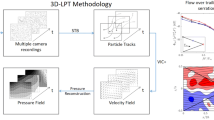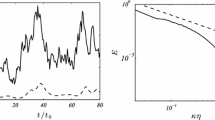Abstract
As a first step toward characterizing coherent structures within the atmospheric surface layer (ASL), measurements obtained via a large-scale particle tracking velocimetry (LS-PTV) system were validated against wind-measurement station data as well as canonical turbulent boundary layer studies. The LS-PTV system resolves three-dimensional, Lagrangian tracks over a 16 m3 volume. Mean-velocity measurements, as well as vertical and shear Reynolds-stress measurements, generally agreed with wind-measurement station data and Reynolds-stress profiles referenced from literature. The probability distributions for streamwise, spanwise and vertical velocity-fluctuation components appear normally distributed about zero. Furthermore, the probability distributions for all three components of Lagrangian acceleration were exponential and followed the parametrization curve from LaPorta et al. (Lett Nat 409:1017–1019, 2001). Lastly, the vorticity probability distributions were exponential and symmetric about zero, which matches findings from Balint et al. (Fluid Mech 228:53–86, 1991). The vorticity intensity measured by the LS-PTV system was less than values from Priyadarshana et al. (Fluid Mech 570:307–346, 2007), which is attributed to the low spatial resolution. However, the average spacing of 0.5 m between tracer particles is deemed sufficient for the future characterization of vortical structures within the ASL.










Similar content being viewed by others
References
Balint J-L, Wallace JM, Vukoslavcevic P (1991) The velocity and vorticity vector fields of a turbulent boundary layer. part 2. statistical properties. Fluid Mech 228:53–86
Biwole PH, Yan W, Zhang Y, Roux JJ (2009) A complete 3d particle tracking algorithm and its applications to the indoor airflow study. Measur Sci Technology 20:1–13
Foken TFW, Mauder M, Thomas C, Liebethal C (2006) Some aspects of the energy balance closure problem. Atmos Chem Phys 6:4395–4402
Hayashi M, Jackson JF, Xu L (2010) Application of the versatile soil moisture budget model to estimate evaporation from prarie grassland. Can Water Resour J 35(2):187
Hommema SE, Adrian RJ (2003) Packet structure of surface eddies in the atmospheric boundary layer. Boundary Layer Meteorol 106:147–170
Honkan A, Andreopoulos Y (1997) Vorticity, strain-rate and dissipation characteristics in the near-wall region of turbulent boundary layers. Fluid Mech 350:29–96
Hutchins N, Nickels TB, Marusic I, Chong M (2009) Hot-wire spatial resolution issues in wall-bounded turbulence. Fluid Mech 635:103–136
Kaimal JC, Finnigan JJ (1994) Atmospheric boundary layer flows-their structure and measurement. Oxford University Press, New York, NY
Kunkel GJ, Marusic I (2006) Study of the near-wall-turbulent region of the high reynolds-number boundary layer using atmospheric flow. Fluid Mech 548:375–402
LaPorta A, Voth GA, Crawford AM, Alexander J, Bodenschatz E (2001) Fluid particle accelerations in fully developed turbulence. Lett Nat 409:1017–1019
Lobutova E, Resagk C, Putze T (2010) Investigation of large-scale circulations in room air flows using three-dimensional particle tracking velocimetry. Build Environ 45:1653–1662
Lüthi B, Tsinober A, Kinzelbach W (2009) Lagrangian measurement of vorticity dynamics in a turbulent flow. Fluid Mech 41:375
Machacek M (2003) A quantitative visualization tool for large wind tunnel experiments. Ph.D. thesis, Swiss Federal Institute of Technology
Marusic I, McKeon BJ, Monkewitz PA, Nagib HM, Smits AJ, Sreenivasan KR (2010) Wall-bounded turbulent flows at high reynolds numbers: recent advances and key issues. Phys Fluids 25:431–442
Marusic I, Uddin AKM, Perry AE (1997) Similarity law for streamwise turbulence intensity in zero-pressure-gradient turbulent boundary layers. Phys Fluids 9(12):3718
Mockett CR (1998) Dispersion and reconstruction. Astrophyical and geophysical flows as dynamical systems. WHOI Tech Report 166:166–188
Pasquill F (1961) The estimation of dispersion of windborne material. Meteorol Mag 90:33–49
Priyadarshana PJA, Klewicki JC, Treat S, Foss JF (2007) Statistical structure of turbulent-boundary-layer velocity-vorticity products at high and low reynolds numbers. Fluid Mech 570:307–346
Raffel M, Willert CE, Wereley ST, Kompenhans J (2007) Particle image velocimetry: a practical guide, 2nd edn. Springer, New York
Rosi GA, Martinuzzi RJ, Rival DE (2013) A conditional analysis of spanwise vortices within the lower atmospheric log layer. Wind Eng Ind Aerodyn 119:89
Scarabino A, Sterling M, Richards PJ, Baker CJ, Hoxey RP (2007) An investigation of the structure of ensemble averaged extreme wind events. Wind Struct 10(2):135–151
Schroeder A, Geisler R, Staack K, Elsinga GE, Scarano F, Wieneke B, Henning A, Poelma C, Westerweel J (2011) Eulerian and lagrangian views of a turbulent boundary layer flow using time-resolved tomographic piv. Exp Fluids 50:1071–1091
Smits AJ, Monty J, Hultmark M, Bailey SCC, Hutchins N, Marusic I (2011) Spatial resolution correction for wall-bounded turbulence measurements. Fluid Mech 676:41–53
Sugiyama G, Nasstrom JS (1999) Methods for determining the height of the atmospheric boundary layer. Lawrence Livermore National Laboratory, Livermore
Sun Y, Zhang Y (2003) Development of a stereoscopic particle image velocimetry system for full-scale room airflow studies: part ii: Experimental setup. Am Soc Heat Refridgeration Air-Conditioning Eng 09:8–540
Townsend AA (1956) The structure of turbulent shear flow, 2nd edn. Cambridge University Press, Cambridge
Zhou J-F, Zhang Q, Li J-C (2005) Probability distribution function of near-wall turbulent velocity fluctuations. Appl Math Mech 26(10):1245–1254
Acknowledgments
The authors wish to thank Alberta Innovates Technology Futures for their financial backing. Thanks also go to Genivar Wind for their generous support in the development and operation of the wind mast. The authors also wish to thank Tyler Christensen and Mohamed Arif Mohamed for their assistance during data acquisition, and Dr. Masaki Hayashi for providing access to his eddy-covariance system.
Author information
Authors and Affiliations
Corresponding author
Rights and permissions
About this article
Cite this article
Rosi, G.A., Sherry, M., Kinzel, M. et al. Characterizing the lower log region of the atmospheric surface layer via large-scale particle tracking velocimetry. Exp Fluids 55, 1736 (2014). https://doi.org/10.1007/s00348-014-1736-2
Received:
Revised:
Accepted:
Published:
DOI: https://doi.org/10.1007/s00348-014-1736-2




